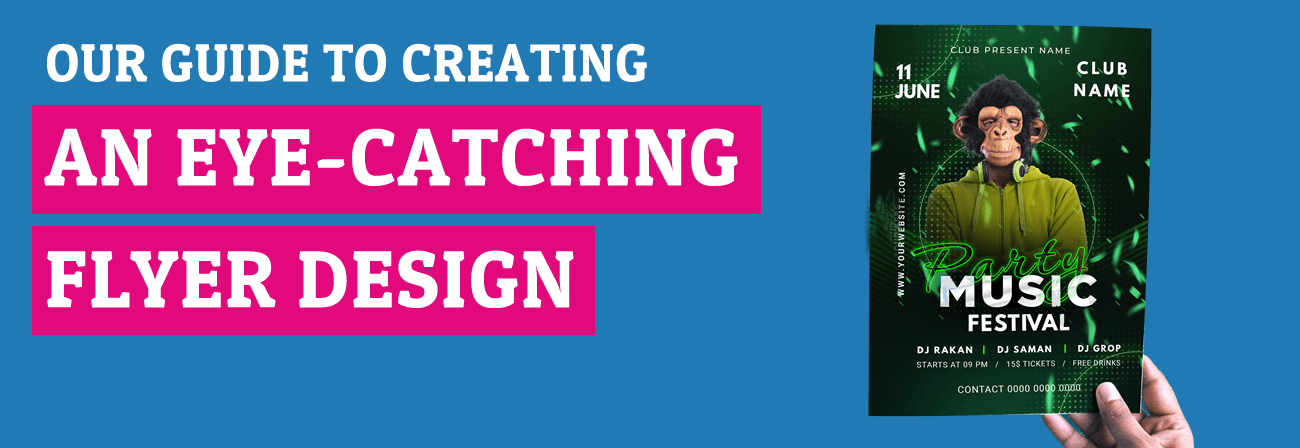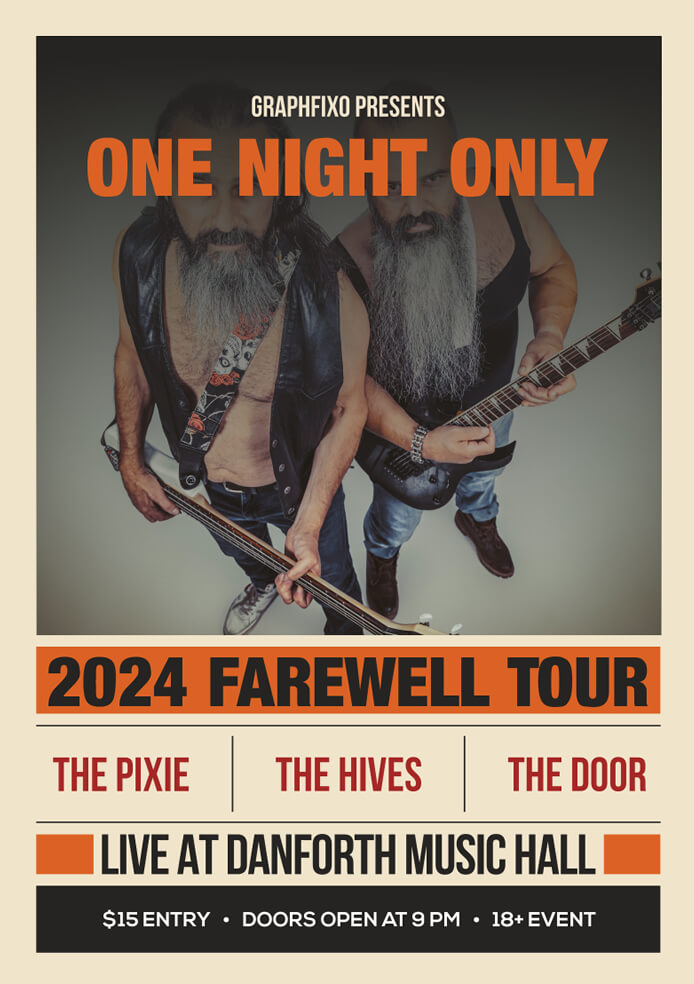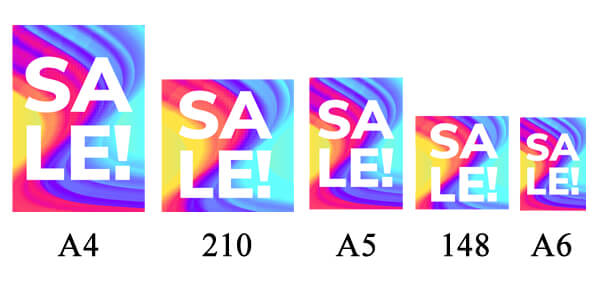Free nationwide shipping on all orders!
Simply, Affordable, Quality Print & Design in Staffordshire and the UK
Free nationwide shipping on all orders!
Simply, Affordable, Quality Print & Design in Staffordshire and the UK

Creating an eye-catching flyer that is not only informative but also has a great design is key to attracting potential customers to learn more about who you are and what you offer. With the help of our ultimate beginners guide, you will go through a list of tricks to create an eye-catching design that will help ensure you stand out for the right reasons.
Clearly understand the purpose and what message you want to convey through the flyer. Put simply it’s what you want you want your flyers to do. Perhaps you are a band designing your flyer for your next event, or you could be a business looking to create another type of flyer. To design a well-designed flyer it’s important to always keep this in mind – the purpose. This is one of the most important flyer design tips – we have seen designs where customers’ flyers aren’t following this rule.
You should always give your flyer a read-over to ensure that you are staying true to the original purpose when you design a flyer.
This is crucial when you begin designing an eye-catching flyer because it allows you to tailor the design, content, and messaging to meet the specific needs of the people you are trying to reach.
If you keep this in mind when you create your flyer it allows you to tailor the content so that it captures their attention and makes them read your flyer. We don’t just mean the wording, but the language and tone you use can help you set the scene.
For example, whether you wish the information to come across as formal, informal, professional or casual. Different audiences will react in different ways to the way something looks and you can use this visual appeal to your advantage – you should keep this in mind.
Prioritizing how the information is laid out within the design is important when you begin to make a flyer design. Using headings and fonts that fall in line with your message with a clear Call to Action (CTA) will help you motivate them and encourage them to take the desired action.
By understanding your audience, you increase the likelihood that your flyer will resonate with the right people, resulting in a more successful and impactful communication campaign. Remember this is what you want when you use flyers to promote your services, products or events!
When creating flyers it’s not just about bright colours and imagery. Sure it plays a part but it’s not all there is. It is a mix of key elements like compelling graphics, fonts, and complementary colours that make your flyer stand out from the crowd. A professional flyer, whether it’s a Valentine’s Day flyer, product flyer, festival flyer, or any other type of flyer, should not miss these fine details.
Headlines make your flyer more interesting! When you craft a catchy headline it immediately grabs the readers’ attention, generating interest and curiosity and making them want to read more. They allow them to quickly ascertain what it is you are promoting, along with helping divide the flyer into sections. Using headlines in this way makes the flyer more visually appealing and easier to navigate guiding readers through the most important information first.
For example, a flyer promoting a band’s upcoming concert could use a large, bold headline like ‘One Night Only – 2024 Farewell Tour!’ at the top to immediately capture attention.

People tend to remember visuals more than text. As such when you use design elements such as eye-catching images in your flyer can make your message stick in the minds of your audience, increasing the chances of making them more likely to engage with the flyer. Using imagery can not only capture their attention but also help you evoke their emotions and create a connection with them.
When you are consistently using high-quality imagery it can complement and reinforce not only your brand but also the text that is on your flyer. They provide visual context that enhances the understanding of the message, making it more persuasive.
Compelling visuals help your flyer stand out from the competition. In a crowded space where multiple messages are vying for attention, unique and captivating imagery can make your flyer more memorable.
When incorporating imagery into your design, ensure that the visuals align with your brand, message, and target audience. Choose images that not only look good but also effectively communicate the key aspects of your promotion or message.
In the same way, choose a colour scheme that aligns with you and your purpose as well as complement your brand. Consistency in colour helps create a cohesive and visually appealing design. Consider using bold colours for key elements.
Along with compelling visuals, thoughtful use of colour also enhances flyers by…
Making sure your flyer is easy to read and ensuring that all information is legible within your flyer design will help potential customers decide to keep your flyer. Use a maximum of two to three to maintain a clean and professional look. Headlines can be bold, while body text should be clear and straightforward.
Using the right font when you make your flyer design not only makes the design more relatable and appealing but ensures that when your customers look at your flyer they quickly absorb the information – remember that’s the prime purpose of flyers! Choosing the right font like imagery and colours can help create the right tone and help reinforce your brand and company identity.
By using various styles, sizes, and weights when you create your own flyer design you can guide the reader’s eye and emphasize key information, creating a clear visual hierarchy.
Here are some great free font options that are well-suited for flyers:
The key is to choose complementary font pairings with contrast – such as a clear, readable body text font with a more eye-catching display font for headlines. Avoid overly decorative fonts and stick with easy to read options.
Once you’ve selected the right fonts for impact, the next key step is…
When it comes to flyer design incorporating branding elements into your design is important for instant brand recognition. If you’re using flyers as part of a broader marketing strategy, (and you really should be) maintaining consistent branding across various channels (flyers, social media, website, etc.) reinforces your brand identity.
Including consistent branding elements such as logos, colours, and fonts lend a sense of professionalism to your flyer. Helping to build a sense of trust and familiarity.
No, we don’t mean just white. Space within a design is one of the best tricks for creating eye-catching flyers. Embrace whitespace to prevent visual clutter. A clean and well-organized layout enhances readability and allows the design to breathe.
Whitespace also contributes to a modern and sophisticated look. Some might say a more elegant design. This is something that should not be overlooked when you begin to make a flyer for your business.
The best flyer size for your message is decided once you know the message and information that you want to include in the design including images, fonts etc you should make an assessment to see how much space you are going to need for your business flyer. For example, an A5 flyer is a great size (one of the most popular choices for flyers) but if you need to display a smaller amount of information then you could use a flyer that’s smaller, such as an A6.
All of our products have blank flyer templates that you can use for your graphic design journey. Simply go to your chosen size and download the flyer template they are all set up with the correct bleed and safety margins to ensure your flyers are designed and ready for print.
By paying attention to these details and tailoring your design to your audience, you can create a flyer that not only attracts attention but also drives engagement. Pick a size that fits your purpose.

There is no right or wrong when it comes to size as it is really dependent on what you are using them for, how much information you have to display comfortably etc.
Below is a list of some of our most common Flat Leaflets and Flyers!
| Size | Size in Millimeters | Size in Inches |
|---|---|---|
| A4 | 210 mm × 297 mm | 8.3 Inches × 11.7 Inches |
| 210mm Square | 210 mm × 210 mm | 8.3 Inches × 8.3 Inches |
| A5 | 148 mm × 210 mm | 5.8 Inches × 8.3 Inches |
| 148mm Square | 148 mm × 148 mm | 5.8 Inches × 5.8 Inches |
| A6 | 105 mm × 148 mm | 4.1 Inches × 5.8 Inches |
We will do them as questions so that you can use them to create your own design brief!
What’s the purpose? To sell more products, highlight a promotion etc.
Who is the target audience? Have we got the right imagery and branding together?
How much space do you need? How much information and imagery have you got that needs to be included within the design? Have we thought about headings and CTA’s to ensure quick and easy information sharing?
It can be as simple sometimes as the basics of WHO, WHAT, WHERE, WHEN and HOW!
By following these essential flyer design tips focused on purpose, audience, visuals, and branding, you’ll be on your way to creating stunning designs whether you’re designing an event flyer, or promotional flyer or are looking to design flyers for something else entirely. If you are still struggling and wish to make sure that your flyer stands out by using our flyer design services then simply get in touch – we would love to help!
